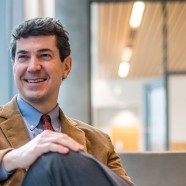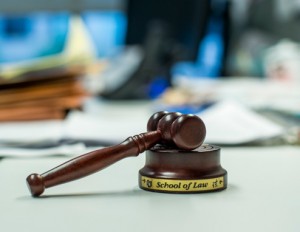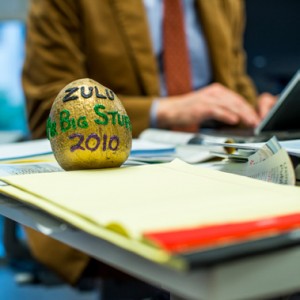
An assistant professor of law and an urban development lawyer, John Marshall “never ever” wanted to be a lawyer. Helping revitalize a city devastated by one of the worst natural disasters in U.S. history was equally outside what John might have predicted for his future.
But every story has roots, and John traces his to the family’s Oldsmobile station wagon. On excursions to visit friends and family in cities up and down the East Coast, John’s architect father and educator mother infused their children with stories about the past and future hopes for these cities, many of which were struggling in the 1970s. These trips sparked a love of urban life in John.
“My dad had always been an idealist,” says John, who grew up in the suburbs of Boston. “He had visions of how communities should be: more inclusive and aesthetically pleasing. He created some beautiful spaces, but the great plans that didn’t get off the drawing board sparked frustration. I grew interested in helping folks like my dad achieve a certain vision. I was attracted to the idea of helping a city neighborhood that was having trouble working prosperously or efficiently, and working together with people to make things better.”
After graduating from the University of Notre Dame, John’s interest in public service led him to a job in Washington working for a congressman. His job—menial tasks—allowed him to “observe the life of a public servant and see how slowly the gears of change actually move. I realized making truly meaningful public change is hard work and takes patience.”
John pursued a master’s in government at the University of Texas, Austin, thinking he might want to teach public policy, but he “realized professors could be far removed from actually helping people make change.” His thesis on the shortcomings of post-WWII neighborhood revitalization programs helped him give voice to what he wanted to do with city revitalization. “I didn’t want to just restore buildings—I wanted to keep families in place, connecting them to jobs and making sure they had local resources like grocery stores, schools and parks.”
 Seeing how lawyers aided John’s father’s work over the years, he knew that a foundation in the law was vital to success in urban revitalization work. So he went to law school (University of Florida, Gainesville), taking courses in land use, historic preservation, and property law. Then the reality of three degrees in higher education set in; it was time to get a job and pay the bills.
Seeing how lawyers aided John’s father’s work over the years, he knew that a foundation in the law was vital to success in urban revitalization work. So he went to law school (University of Florida, Gainesville), taking courses in land use, historic preservation, and property law. Then the reality of three degrees in higher education set in; it was time to get a job and pay the bills.
After a two-year clerkship with a federal judge, John chose to work with Holland & Knight LLP, in the firm’s Tampa office, hoping to focus on environmental and land-use law. But the firm asked him to get involved in complex commercial litigation in federal court for one year. “At Milton, I learned to be a team player, so I agreed. Plus I would be mentored by some wonderful lawyers. But one year led to two. Suddenly, three and half years into it, I was watching New Year’s fireworks from my office window and missing the weddings of my Milton friends. I felt isolated. This wasn’t a case of work/life balance. It was just work.”
He moved to the real estate side of the firm, but as a litigator who “helped cities sprawl—enabling big-box stores and condominiums in place of old orange groves or cow pastures. I was not happy.” He started searching for opportunities more aligned with his beliefs.
In the fall of 2007, he received a Rockefeller Foundation fellowship to work with the New Orleans Redevelopment Authority (NORA). Two years after Hurricane Katrina, revitalization, the city’s progress toward recovery, was painfully slow. Some streets lacked working streetlights; vacant homes were everywhere. With his 18-month appointment, John was excited about the challenge: Help NORA legally recover long-blighted and abandoned properties so that they could be redeveloped as private, affordable housing for families that wanted to live in their former neighborhoods.
“I was confident because of my training, but I quickly realized how little I knew about working with families trying to return to their neighborhoods,” says John. “At my first public meeting, I was by myself, in a restored church sanctuary in the Lower Ninth Ward. I couldn’t even pronounce the street names correctly. I was the only white person there and I had zero credibility with these families and neighborhood groups, and rightly so. For two years, these people had been trying to regain their homes and the Redevelopment Authority couldn’t even send someone who could pronounce the street names correctly!”
As he had before when he faced challenges, John drew on advice a Milton football coach gave to the “scrawny, 145-pound junior varsity defensive end.” He said, “Always keep your feet moving.” He also kept close the words of a Milton classmate’s father, who told John, a baseball fanatic to this day, “pick up the ground balls that come to you, and if you play those well, it will lead to something.”
 He immersed himself in the culture and life of the city and its residents, learning every “nook and cranny” of the neighborhoods, and familiarizing himself with local laws and processes. NORA’s original plan relied on eminent domain, government’s ability to expropriate private property for public use, a process the Louisiana legislature made more difficult before John arrived. He became part of a team that brought a constitutional challenge to the Louisiana Supreme Court to change the legislature’s action. Meanwhile, his colleagues filed hundreds of eminent domain actions in neighborhoods across the city. They were understaffed and under-resourced—and federal aid dollars to buy back properties was slow to arrive.
He immersed himself in the culture and life of the city and its residents, learning every “nook and cranny” of the neighborhoods, and familiarizing himself with local laws and processes. NORA’s original plan relied on eminent domain, government’s ability to expropriate private property for public use, a process the Louisiana legislature made more difficult before John arrived. He became part of a team that brought a constitutional challenge to the Louisiana Supreme Court to change the legislature’s action. Meanwhile, his colleagues filed hundreds of eminent domain actions in neighborhoods across the city. They were understaffed and under-resourced—and federal aid dollars to buy back properties was slow to arrive.
John’s 18-month appointment was extended for two more years, and eventually the original strategy was jettisoned. The team finished the actions they had filed and instead focused on the 5,000 properties sold back to the state by families who chose to leave New Orleans. These properties gave NORA significant land holdings in every neighborhood and a chance to carry out the goals. Still understaffed and underfunded, they began appealing to graduate programs around the country—law schools, M.B.A. programs, public policy programs—for students willing to work without pay in an internship program that John developed. Progress was still slow, but this new strategy was more successful.
John realized he loved working with the students. He enjoyed reviewing their work and counseling them about their careers. He reflected on what he saw as a lack of leadership training and of developing effective communication and interpersonal skills in law school education. In New Orleans, these were important skills for him.
“Lawyers have special capital; people expect they know what they are talking about and that they will provide a way forward. But if you are not an effective communicator, if you are not able to bridge differences of opinion maybe regarding race or class, if you are not able to work in a resource-constrained environment or a time-pressured environment, you are at a real disadvantage, and you are not serving your client or community well. I spent a lot of time in New Orleans thinking about lawyers as leaders.”
John shifted his plan to remain in New Orleans, eager to get involved in training the next generation of urban development lawyers. He became the Ludwig Community Development Fellow at Yale Law School, serving as a clinical lecturer in law. He is now an assistant professor of law at Georgia State University, in the heart of Atlanta. He teaches environmental and property law and recently co-edited a book, How Cities Will Save the World. In John’s old-city neighborhood, he advises local neighborhood associations on revitalization efforts. He brings urban professionals into his classrooms so students learn not only the principles of law from the casebooks but also hear stories about legal work on the ground.
“I want my students to engage in work that makes them happy. Law and urban redevelopment makes me happy because I’m working elbow to elbow with neighbors, reviewing ideas for development and proposals for funding, and tending to the nitty-gritty of easements and purchase and sales agreements. When the purpose is to make a community work better, more efficiently to stay intact, that’s exciting to me, and I’m grateful to be able to do that work.”
by Liz Matson



